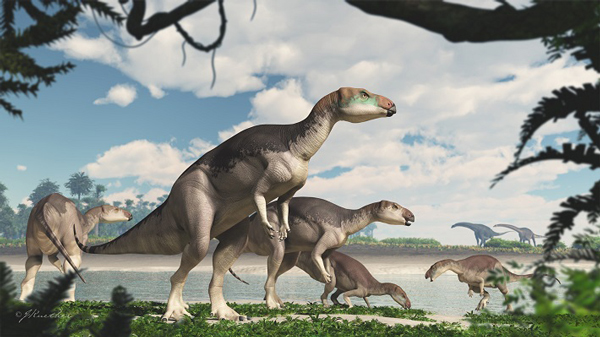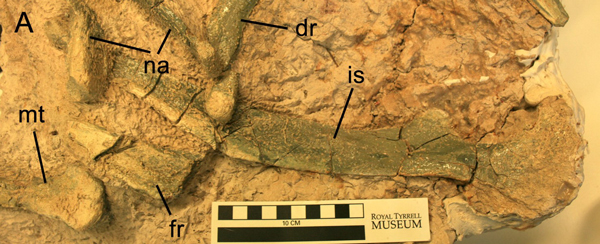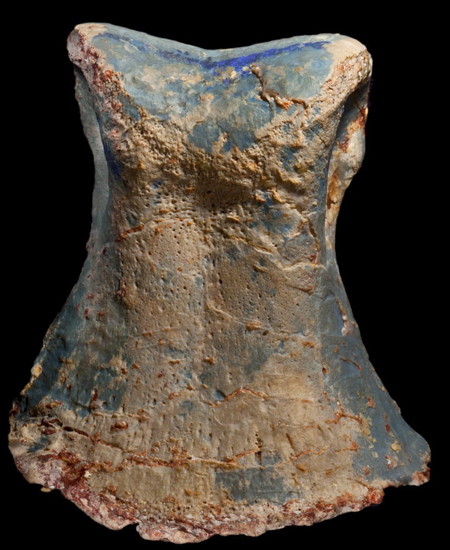A New Dinosaur is Described! Have you Herd of Fostoria dhimbangunmal?
Australia’s Newest Dinosaur Fostoria dhimbangunmal – A Gem of a Fossil Discovery
A team of scientists from the University of New England (New South Wales, Australia), in collaboration with the Australian Opal Centre, have announced the discovery of yet another Aussie dinosaur. The dinosaur has been named Fostoria dhimbangunmal (pronounced Foss-taw-ree-ah dim-baan-goon-mal) and it has been identified from a series of opalised fossils representing a number of individual animals excavated from an opal mine near Lightning Ridge (New South Wales).
Fostoria dhimbangunmal
The herbivorous dinosaur, which would have measured around 5-6 metres in length when fully grown, has been classified as an iguanodontid and phylogenetic analysis based on a recently published data set positions Fostoria as the sister taxon to a clade of Gondwanan iguanodontians that includes Anabisetia saldiviai, Talenkauen santacrucensis (both from Argentina) and arguably, Australia’s most famous ornithopod – Muttaburrasaurus langdoni.
A Life Reconstruction of Fostoria dhimbangunmal

Picture credit: James Kuether
Evidence of a Herd of Plant-eating Dinosaurs
The fossil material has been opalised and it represents the remains of at least four different animals of different sizes/ages preserved in a monodominant bone bed excavated from the underground opal mine. Opalised individual fossils of dinosaurs have been found in this part of New South Wales before, but it is remarkable that so many body fossils have been opalised in this case.
Lead author of the scientific paper, published in the “Journal of Vertebrate Paleontology”, Dr Phil Bell (University of New England), stated that he was stunned by the sheer number of bones that had been found. He explained:
“We initially assumed it was a single skeleton, but when I started looking at some of the bones, I realised that we had four scapulae (shoulder blades) all from different sized animals.”
Finding these fossils in the same place suggests that these are the remains of a group of dinosaurs that travelled together, as such, this is the first instance of a “herd of dinosaurs” being discovered in Australia.
Fossil Material – Elements from the Forelimb and Shoulder Girdle

Picture credit: Journal of Vertebrate Paleontology
The picture (above), shows views of a left scapula (A, B and C). Views of the left humerus (D, E and F) along with views of the left radius (G, H and I), scale bar = 2 cm.
The First Partial Skull of a Dinosaur from New South Wales
Most parts of the body are represented by the fossils, including elements from the skull such as the quadrate and other fossil bones that make up the braincase. The frontal bones have enabled the researchers to compare the skull roof of Fostoria to other iguanodontids and hypsilophodontids which has helped with classification.
Fossils of Fostoria dhimbangunmal Exposed

Picture credit: Journal of Vertebrate Paleontology
Honouring Robert Foster
The genus name honours opal miner Robert Foster, who discovered the bonebed in the 1980s. The species name comes from the language of the Yuwaalaraay, Yuwaalayaay, and Gamilaraay peoples, after the Sheepyard opal field where the bonebed is located. Scientists and field team volunteers from the Australian Museum in Sydney helped excavate the fossils, but the bones remained unstudied until donated to the Australian Opal Centre by Robert’s children Gregory and Joanne Foster back in 2015.
A View of an Opalised Toe Bone (F. dhimbangunmal)

Picture credit: Robert A. Smith/Australian Opal Centre
Commenting on the significance of these fossils, palaeontologist and special projects officer, Jenni Brammall of the Australian Open Centre said:
“Fostoria has given us the most complete opalised dinosaur skeleton in the world. Partial skeletons of extinct swimming reptiles have been found at other Australian opal fields, but for opalised dinosaurs we generally have only a single bone or tooth or in rare instances, a few bones. To recover dozens of bones from the one skeleton is a first.”
An Important Gondwanan Representative of the Iguanodontians
Although most palaeontologists believe that the iguanodontid dinosaurs were very speciose and diverse during the Early Cretaceous, fossils representing iguanodontids from southern latitudes, what would have been the super-continent of Gondwana, are quite rare. For example, until Fostoria was described, only one Australian iguanodontid dinosaur – M. langdoni, was known. Fostoria dhimbangunmal extends the temporal range of these types of dinosaurs in Australia to the Cenomanian (early Late Cretaceous). It and Muttaburrasaurus are the only iguanodontians known from the eastern margin of the inland sea, the Eromanga Sea, whereas the group is conspicuously absent from the contemporaneous ornithopod-dominated ecosystems of the Australian-Antarctic rift valley in Victoria.
To read about a recent ornithopod addition to the biota of the Australian-Antarctic rift valley: New Australian Ornithopod Described – Galleonosaurus dorisae.
The scientific paper: “Fostoria dhimbangunmal, gen. et sp. nov., a new iguanodontian (Dinosauria, Ornithopoda) from the mid-Cretaceous of Lightning Ridge, New South Wales, Australia” by Phil R. Bell, Tom Brougham, Matthew C. Herne, Timothy Frauenfelder and Elizabeth T. Smith published in the Journal of Vertebrate Paleontology.
Visit the Everything Dinosaur website: Everything Dinosaur.

